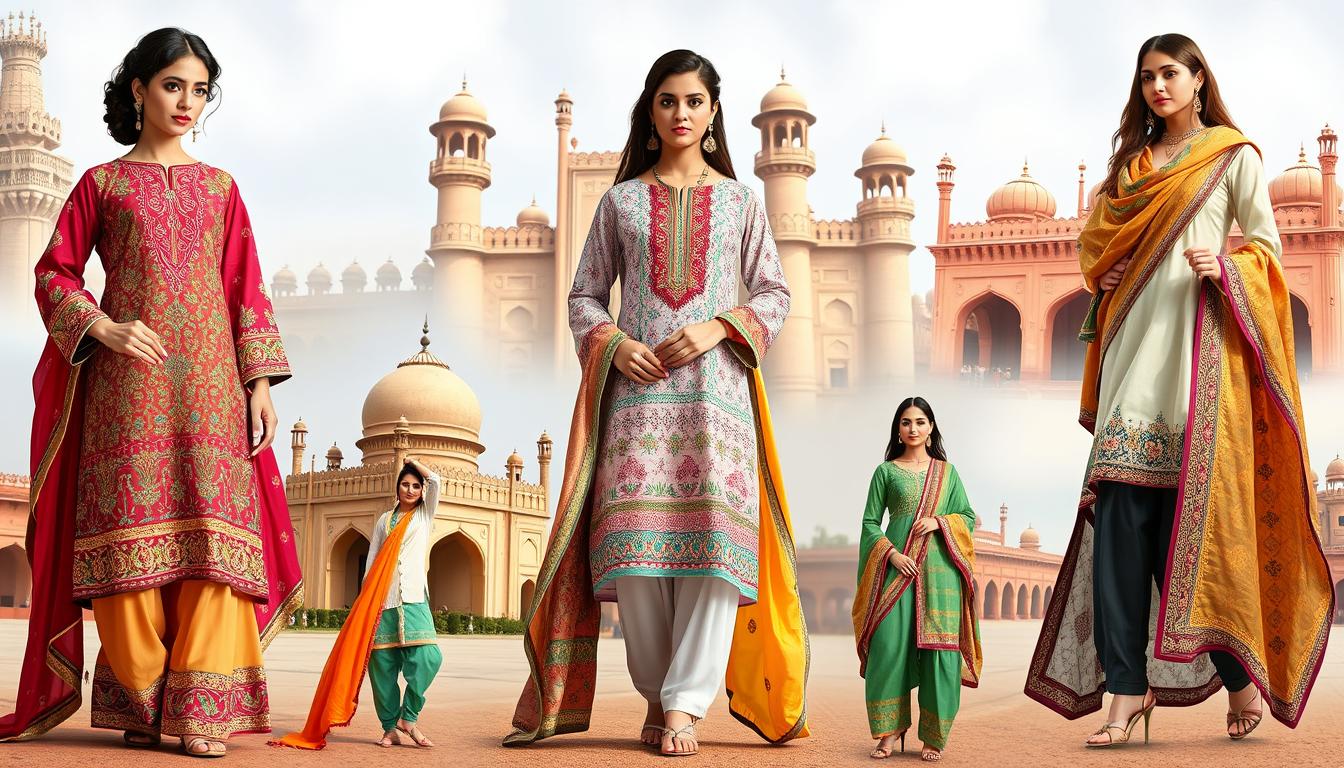Pakistan’s fashion has changed over the years, mixing cultural influences and artistic traditions. The Mughal Empire’s grandeur and Western styles during colonial times have shaped it. Today, Pakistani fashion keeps its heritage alive while embracing new trends.
This journey shows how Pakistani fashion has stayed true to itself and gained global fame. It’s known for its detailed work and fresh designs, winning hearts around the world.
Key Takeaways
- Pakistani fashion has a rich history spanning centuries, shaped by diverse cultural influences.
- The industry has skillfully blended traditional craftsmanship with modern design sensibilities.
- Pakistani fashion has gained international recognition through participation in global fashion events.
- Sustainable and ethical fashion initiatives are empowering local artisans and preserving cultural heritage.
- Emerging trends in Pakistani fashion point to a bright and dynamic future for the industry.
The Dawn of Pakistani Fashion
The roots of Pakistani fashion go back to the Mughal Empire. This empire greatly influenced the region’s clothing traditions. The salwar kameez, ornate shawls, and detailed embroideries became key parts of Pakistani style.
These styles vary by region, shaped by local customs and materials. This rich heritage has helped build Pakistan’s vibrant fashion scene.
Influences from the Mughal Empire
The Mughal Empire ruled the Indian subcontinent for centuries. It greatly shaped Pakistan’s textile history and traditional clothes. The Mughals loved fine fabrics, lavish embroideries, and diverse cultures.
This legacy is seen in the salwar kameez. It combines Mughal and local designs, making it a timeless favorite.
Traditional Attire and Regional Variations
Pakistani fashion has grown with unique regional styles. Each province has its own clothing identity. Balochi embroidery in the west and Sindhi traditional clothes in the south are examples.
This variety makes Pakistani fashion rich and diverse. It’s a mix of Mughal Empire influence, traditional Pakistani attire, regional fashion variations, and textile history.
“Pakistani fashion has evolved with distinct regional variations, reflecting the country’s rich cultural tapestry.”
Colonial Era and the Influx of Western Styles
The arrival of colonial powers in the subcontinent had a big impact on Pakistani fashion. New styles and silhouettes were introduced, and local designers and artisans started to mix these with traditional fashion. This led to a beautiful blend of Eastern and Western aesthetics, fitting the region’s culture and climate perfectly.
The colonial era set the stage for a unique fashion identity in Pakistan. It combined international styles with the timeless beauty of traditional craftsmanship. This fusion of styles not only made fashion more interesting but also influenced Western fashion in Pakistan to this day.
“The colonial era in Pakistan marked a transformative period, where traditional garments seamlessly intertwined with the allure of Western silhouettes, creating a captivating fusion of styles that defined the nation’s fashion identity.”
As the colonial influence grew, local designers and artisans found a way to keep cultural heritage alive while also embracing Western fashion trends. This led to a unique style that spoke to the dreams of the Pakistani people.
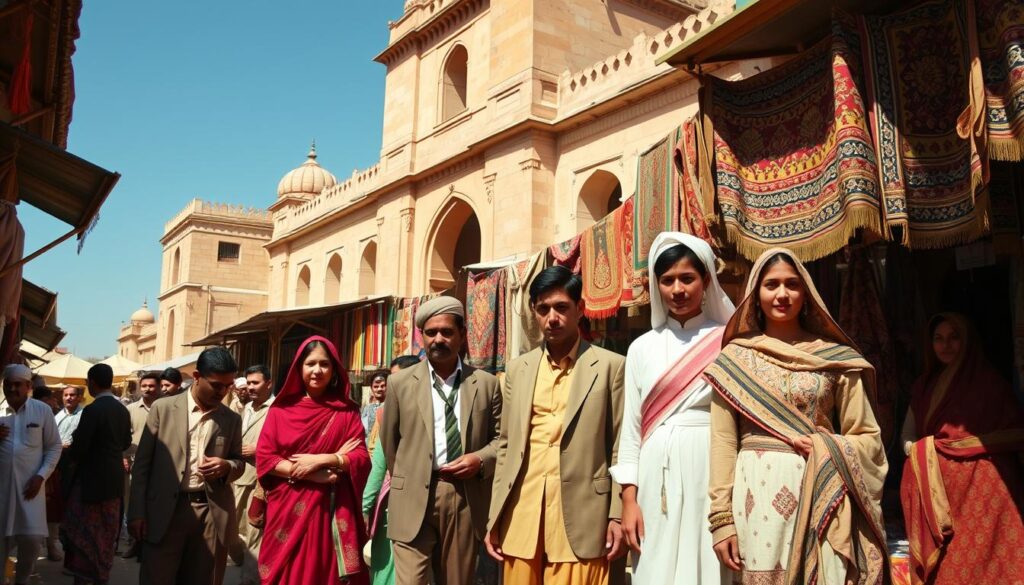
The fusion of styles during the colonial era laid the groundwork for Pakistan’s diverse and vibrant fashion scene. It merged the timeless elegance of tradition with the modern charm of Western fashion trends.
Pakistan Fashion
After independence, Pakistan’s fashion scene burst into life. Talented local designers and brands started to shine. Maheen Khan, Rizwan Beyg, and Deepak Perwani were among the first to lead the way. They mixed Pakistan’s rich culture with modern styles.
This mix made Pakistani fashion a source of pride and fame worldwide.
The Rise of Local Designers and Brands
Local designers and brands have driven the growth of Pakistani fashion. They’ve shown off the country’s cultural variety and brought Pakistani style to the world. Sana Safinaz, Elan, and Sapphire are just a few names that have made a mark globally.
These designers have empowered people to celebrate their cultural heritage. They’ve combined old-world craftsmanship with new designs. This has created a unique Pakistani fashion identity loved by all.
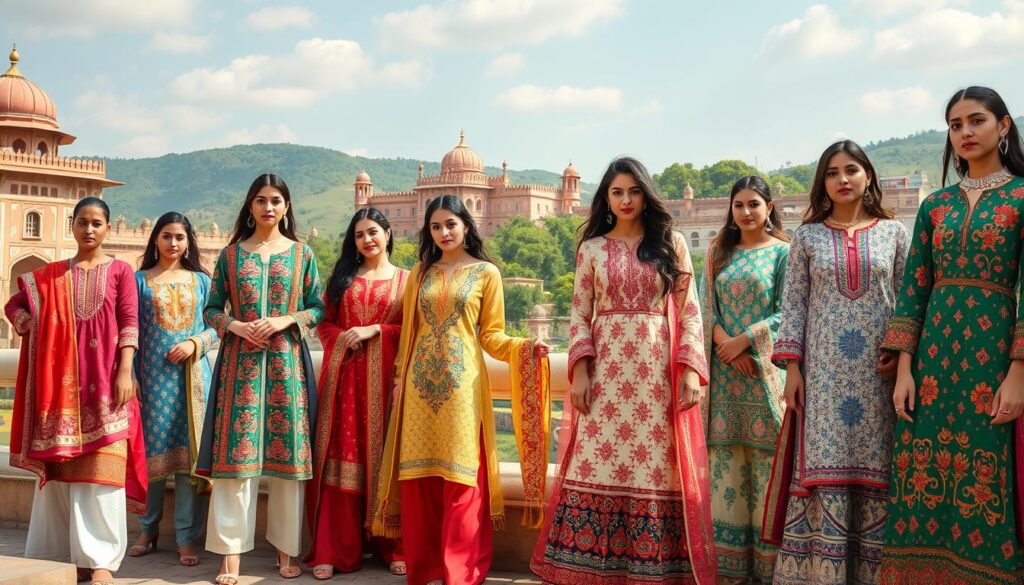
“The Pakistani fashion industry has evolved tremendously over the years, showcasing the country’s rich cultural heritage and the immense talent of our local designers and brands. This dynamic industry continues to be a source of national pride and global recognition.”
The Pakistani fashion industry is still growing. The impact of local designers and brands will only get stronger. This will make Pakistan a key player in the world of fashion.
Bridging the Old and the New
Pakistani fashion stands out by mixing old skills with new designs. Designers keep traditional techniques alive, like intricate embroidery and weaving. They also add modern styles to their work. This blend has made Pakistani fashion popular worldwide, showing off the country’s culture and talent.
Fusion of Styles
The fusion of styles is key in Pakistani fashion. Designers combine old methods with new ideas. They use traditional patterns and modern shapes, creating something new and exciting.
“Pakistani fashion has the unique ability to seamlessly blend the old and the new, creating garments that are both culturally rooted and globally relevant.”
This approach has won fans everywhere. It shows Pakistani fashion’s depth and flexibility. Designers keep the country’s textile traditions alive while bringing in fresh styles. This makes Pakistani fashion stand out to people all over the world.
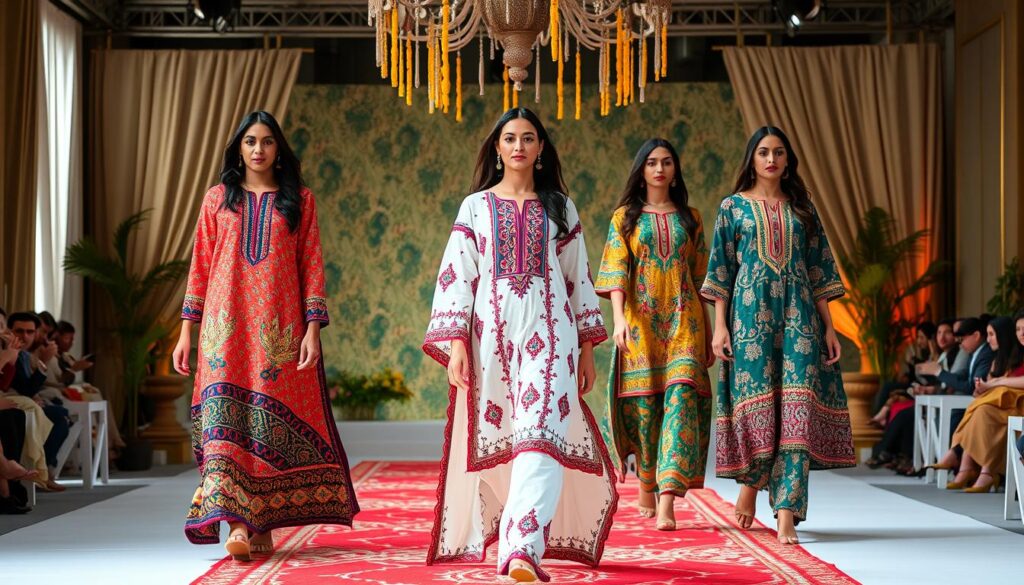
The Lawn Revolution
The Pakistani lawn has changed a lot, catching everyone’s eye with its bright colors and detailed designs. It’s more than just fabric; it’s a symbol of culture, loved by women of all ages.
Designers in Pakistan have made lawn fabric fancy and stylish. They’ve mixed old traditions with new ideas, making lawn a big fashion statement. This shows off Pakistan’s rich culture and modern fashion sense.
The Pakistani lawn is now a place for artists to show their skills. Designers use lawn to create everything from pretty flowers to cool geometric shapes. This makes lawn a hit with fashion lovers everywhere.
“The lawn has become a symbol of Pakistani pride, a reflection of our nation’s vibrant cultural tapestry and innovative spirit.”
The lawn revolution has changed fashion in Pakistan and made it famous worldwide. People from all over love the detailed Pakistani lawn designs. This makes Pakistan known for its amazing textiles and culture.
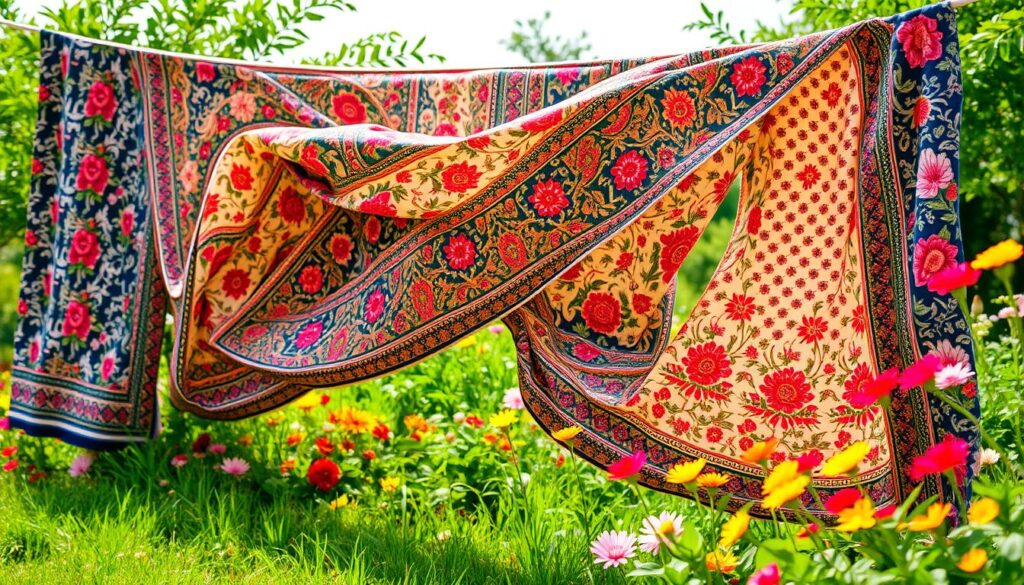
The Pakistani lawn has made people proud of their heritage. It’s a way to show off Pakistan’s history and the talent of its designers and craftspeople.
The Global Resonance of Pakistani Fashion
Pakistani fashion has won hearts worldwide, gaining international fame. Pakistani designers and brands have shown off their nation’s rich culture and unique style at top fashion events. These events have led to a deep cultural exchange, letting the world see Pakistani fashion’s artistry and skill.
Pakistani fashion has made a big splash at international fashion weeks and exhibitions. It has shown the world the country’s fashion talent. This has made Pakistani fashion well-known globally, blending tradition with modern trends.
“Pakistani fashion is more than just clothes; it’s a tapestry of our nation’s rich history and the collective creativity of our people. These global fashion events allow us to share our unique voice with the world, fostering a deeper appreciation for the cultural exchange that defines the global fashion influence of Pakistan.”
Pakistani fashion keeps getting international praise. It shows the country’s lasting cultural heritage and its ability to connect with people everywhere.
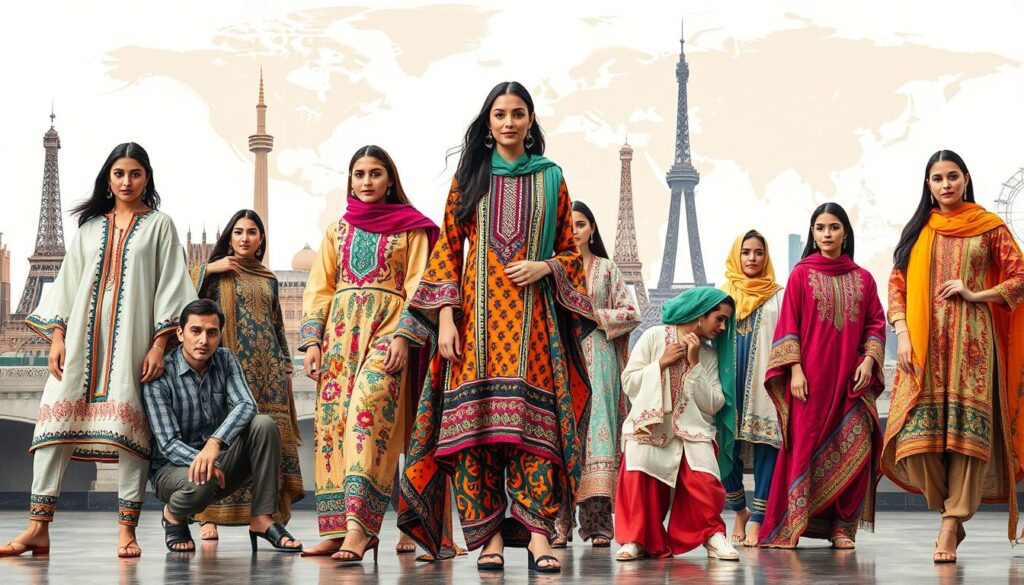
Preserving Cultural Heritage Through Fashion
The Pakistani fashion industry is a key player in keeping the country’s cultural heritage alive. Designers and artists are working hard to bring back old textile techniques. They focus on Ajrak printing, Kashmiri embroidery, and Sindhi Rilli weaving to ensure these crafts are not lost.
By mixing these traditional methods with modern designs, Pakistani fashion celebrates the nation’s rich history. This way, the industry honors and protects the country’s cultural legacy.
Pakistani fashion stands out as a beacon for cultural preservation through artisanal crafts and traditional techniques. Designers blend old and new, creating unique pieces that showcase the country’s heritage. This approach allows Pakistani designers to share their culture with the world, sparking a deeper appreciation for it.
“Fashion is not just about clothes; it’s a reflection of our cultural identity. By preserving and celebrating our traditional crafts, we are ensuring that the stories and traditions of our people live on through the garments we create.”
The Pakistani fashion industry’s role in preserving cultural heritage is growing. Designers are not just making stunning clothes; they are also protecting the nation’s history. Their dedication to cultural preservation through fashion shows the power of art and creativity in shaping a nation’s story.
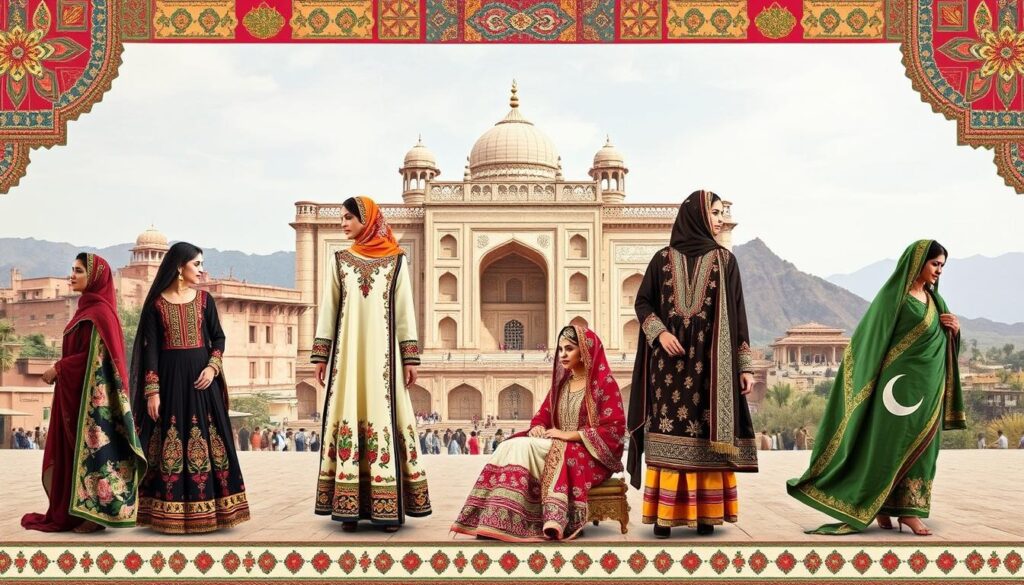
Ethical and Sustainable Fashion Initiatives
Pakistani fashion is now focusing on ethical and sustainable practices. Designers and brands are working to support local artisans and craftspeople. They ensure fair wages and promote traditional techniques.
These efforts help preserve cultural heritage and empower marginalized communities. They also make the fashion industry in Pakistan more responsible.
Empowering Local Artisans and Craftspeople
Pakistani fashion brands are now focusing on sustainable and ethical practices. They are working with local artisans and craftspeople. This helps showcase the rich cultural heritage of the region.
It also provides steady income and empowers these communities. This supports traditional craftsmanship and has a social impact beyond fashion.
“Fashion has the power to transform lives and communities. By embracing sustainable practices and empowering local artisans, we can create a more equitable and responsible fashion industry in Pakistan.”
These efforts have caught the attention of consumers in Pakistan and around the world. They have made Pakistan known for ethical fashion and responsible practices. As the industry grows, the focus on local artisans and social impact will keep shaping Pakistani fashion.
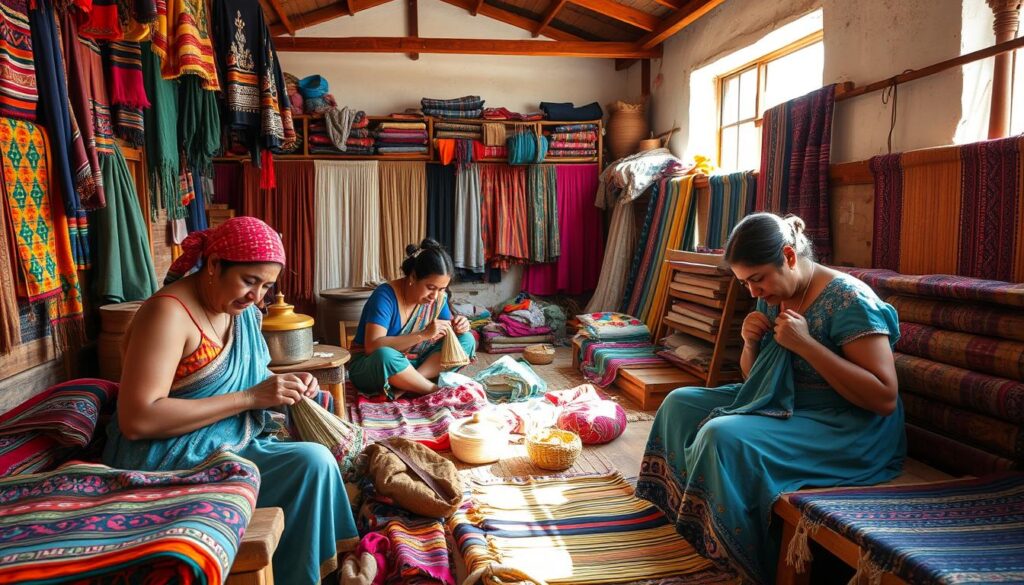
Emerging Trends and Future Directions
The Pakistani fashion industry is growing fast, with new trends leading the way. Sustainable and inclusive fashion, along with digital tech, are changing the game. These changes will help Pakistani designers and brands reach even more people worldwide.
Now, there’s a big push for ethical and eco-friendly fashion. Designers are using green materials and fair labor. This meets the growing need for fashion that’s good for the planet and people.
Traditional skills are being mixed with modern tech in Pakistani fashion. Old techniques like embroidery meet new styles and designs. This mix keeps the country’s fashion rich and fresh, making it a global leader.
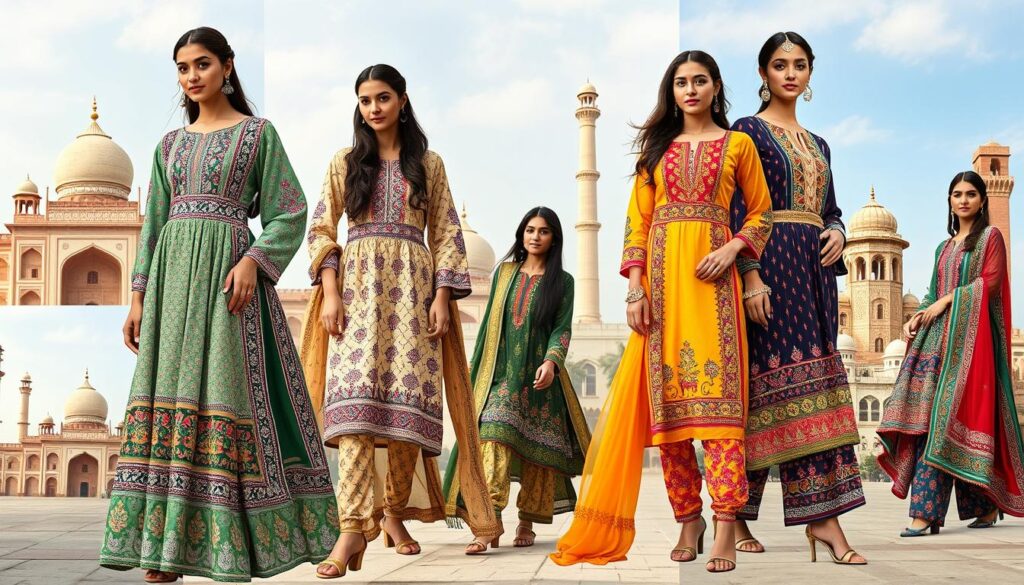
Pakistani fashion is becoming more known around the world. Fashion weeks, designer teams, and online shops are showing off Pakistani style. This makes Pakistan a key player in the fashion world.
Pakistani fashion is all about blending old traditions with new ideas. It’s focused on keeping cultural heritage alive while reaching new heights of success. This approach is making Pakistani fashion a global force.
The Role of Social Media and Influencers
Social media and fashion influencers have changed how Pakistani fashion is seen and shared. Designers and brands use these platforms to reach more people, show off their designs, and talk directly to customers. This has made Pakistani fashion more visible and appealing worldwide, opening up new ways for creativity and building brands.
Fashion influencers, with their big social media followings, are big supporters of Pakistani fashion. They share their favorite local designers and personal style stories. This has sparked a new interest in traditional and modern Pakistani fashion trends.
This digital word-of-mouth has been key in introducing Pakistani fashion globally. It has broken down barriers and increased interest from consumers.
The smart use of social media and influencer marketing has helped Pakistani fashion brands connect with their audience. They use eye-catching content, interactive campaigns, and ads to grow their online presence. This has attracted a new crowd of fashion lovers.
This digital shift has not only made brands more visible but also helped people understand and value Pakistani fashion’s heritage and creativity.
- The Dawn of Pakistani Fashion
- Colonial Era and the Influx of Western Styles
- Pakistan Fashion
- Bridging the Old and the New
- The Lawn Revolution
- The Global Resonance of Pakistani Fashion
- Preserving Cultural Heritage Through Fashion
- Ethical and Sustainable Fashion Initiatives
- Emerging Trends and Future Directions
- The Role of Social Media and Influencers
